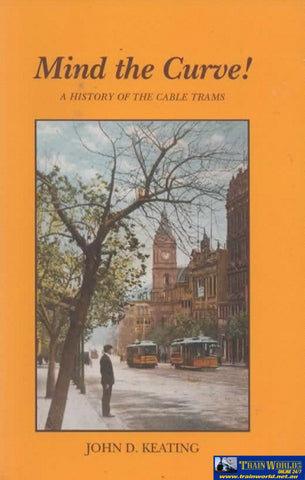Mind the Curve!: A History of the Cable Trams (TA-02)
Product No.: TA-02
Title: Mind the Curve!: A History of the Cable Trams
Author(s): Keating, John D.
Publisher: Transit Australia Publishing
ISBN: 0909459193
Condition: New
Binding: Softcover
Dust Jacket: No Jacket
Edition: Reprint
Publication Year: 2001
Features: 155 Pages with Black/White Photos.
Operating from 1885 until 1940, Melbourne's cable tram system was the fourth biggest in the world, with about 75 km of double track, 17 inner-suburban routes, and 600 cable car and trailer sets. Cable trams depended for their motive power on a cable in a slot between the rails, kept moving by an engine house along the route. In the first car (the dummy), the driver (the gripman) worked the levers that gripped the cable to make the tram move. Passengers could ride in the dummy, but apart from the roof it was quite open. To warn passengers to hold on when the tram departed from a straight line, the gripman usually called 'mind the curve!'
The second car was more like a conventional small tram, but was only a trailer, pulled along by the dummy. Melbourne's first cable tram ran on 11 November 1885 from Spencer Street along Flinders Street and Bridge Road Richmond, about 5 km to Hawthorn Bridge. The last ran on 26 October 1940 from the intersection of Spencer and Bourke streets to the terminus at Northcote. Although built over eight years by a Tramway Trust formed by 12 inner-city municipalities, Melbourne's main cable tram routes were until 1916 run by the Melbourne Tramway and Omnibus Co., a private enterprise operation managed by Francis Boardman Clapp and Henry Hoyt.
The economic collapse of the early 1890s limited further development of the network which remained the crux of Melbourne's street transport system until the late 1920s. Independent electric tram systems were set up as feeder lines to the cable tram terminuses. After the whole system was taken over by the Victorian Government, electric trams began to appear in the city. They replaced cable trams in Swanston Street in 1926, Flinders Street in 1927, Collins Street in 1929 and, finally, Bourke Street in 1940. Traces of the cable tram system are barely visible in the city landscape. Rathdowne Street owes its median strip to the North Carlton-St Kilda line, closed in 1936, the engine house at Park Street now converted to apartments. The restored Cable Tram No. 1 is on display at Melbourne Museum.



